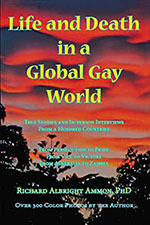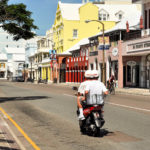By Richard Ammon
GlobalGayz.com
June 20, 2010
For more than forty years I took photos wherever I went–local family and friends, distant lands, famous landmarks, oceans, landscapes, handsome people, unexpected moments… or myself in 1990 (photo right). Whatever came into view that appealed to my sensuous eye or aesthetic intuition. Hundreds, thousands of images accumulated into hard-copy albums with plastic sleeves. Forty, fifty albums spreading up and down and across my study. Massive.
Then came digital cameras, SD cards and even more thousands of photos. But the hard copy albums stopped and iPhoto took over, now reaching toward 25,000 images that take up the space of a fingernail.
It became evident that the albums had to go digital as well so I hired a young friend with time on his hands to take the albums apart, photo by photo. It took him a month and the photos filled two large cardboard boxes.
The final impetus to go from hard to digital came when I discovered the brilliant technology of the Kodak Multi-scanner in a local photo store that could scan hundreds of photos onto a DVD in a few minutes. My decision was made for me.
I now have two DVDs of my hard photos, about 6,000 on each disc ranging from 1970 to the present, some of which will some day be edited and posted into photo galleries on my website GlobalGayz.com.
But this blog is not about digital photography, miracle that it is.
This blog is about letting go of some images of my past, about aging and having bigger decisions made as I age, about memories and what they are and what they mean.
It’s easy to say the bulk of these colored glossy prints should just be tossed as so much clutter or excessive bits of paper to be taken away. But not so fast. The hesitation is that each photo I see is a moment of my life and how do I toss away moments of life?
Across the span of 60 or 80 years the mind absorbs billions of fragments–sights, sounds, touches, feelings and so on. Precious few of these are caught on film and frozen into a chemical or digital still while the rest are slowly forgotten for months or years or forever. Forgotten but not totally lost. Suddenly a photo from high school, or Nepal or Morocco or an ancestor or the GayGames of 1986, or my mother in 1977 (photo right) brings back the scene, a particular moment of life from long or short ago, reconnecting my present mind with a past that I lived in and passed through.
Of all the moments of our lives, we remember exceedingly few, the peaks of marriage, death, love or injury or beauty or war. The billions of others just flow on by as if they never happened, unrecalled among the countless mushy chemistry of brain cells. Some experiences we need or want to forget; usually we didn’t take photos of hard times that left scars or deformities.
Most others are seemingly forgotten but not in the presence of a photo. These are the moments of my mortal life and I do want to remember them; I want to remember as much of my life as possible, to continue the meaning of my life, uncertain what that means.
Photos reveal the tapestry of my life. I want to see as much of it as possible, not toss it out, not forget it while I’m alive. Death will close my gallery soon enough and the rest will be silent and invisible. Until then, I will continue collecting images, collecting memories, collecting my life and adding to the tapestry.
















